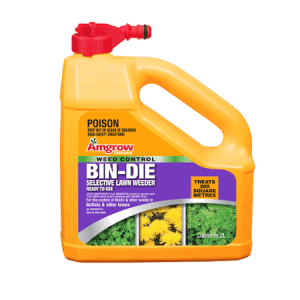Getting Oxalis Weed In Your Yard?
Weeds can be a real problem in any lawn. And Oxalis is one really persistent offender that may have made its appearance this spring in your lawn.
With its brightly coloured flowers it really stands out. Oxalis weeds can wreak havoc very rapidly in your pristine turf and your garden and is very difficult to remove completely once established.
What is Oxalis Weed?
A number of species from the Oxalis family of plants can quickly establish themselves as unwanted weeds.
The Oxalis family generally originate in hot climate countries such as Africa and South America and so can easily adapt to life under Australian conditions.
The members of the Oxalis family that cause particular problems include:
- Oxalis corniculata
- Oxalis corymbosa
- Oxalis pes-capraea
- Oxalis stricta
Oxalis might easily be mistaken for clover with its green heart-shaped leaves (clover leaves are more rounded) but the small yellow flowers give it away.
Oxalis is known by other names such as creeping oxalis (Oxalis corniculata), wood sorrel or yellow sorrel (Oxalis pes-capraea).
Oxalis corniculata is the species that is especially rampant in lawns and it can be distinguished by the heart-shaped leaves approximately 0.5–1 cm long and 0.5–2.5 cm wide.
The small yellow flowers measure around 0.5cm in diameter.
How to Control Oxalis
Oxalis quickly spreads across your lawn thanks to a creeping runner system that expands across your lawn sending down roots to form new plants.
Its further strengthens its stranglehold on your lawn with explosive seed pods that shoot seeds to a great distance from the parent plant.
Prevention is always the best cure. By keeping your turf in a good healthy state, well fed and watered and promptly repairing damage you can prevent weeds such as Oxalis from getting a foot hold.
If you have only a small infestation you can try removing the weeds by hand. You need to be very careful about digging up and pulling out oxalis.
Removing the weeds by hand typically leaves behind small sections that will quickly form new roots and plants.
Some types of Oxalis also form clusters of small bulbils underground and some of these bulbs will invariably be left behind when you remove the parent plant.
Avoid dumping the Oxalis weeds in the compost as the bulbils will most likely survive and thrive.
Unfortunately, Oxalis is often resistant to many standard herbicides.
You’ll also need to choose the correct herbicide because you can easily kill your lawn with many of the commonly used herbicides.
What’s the Best Weed Killer for Oxalis?
The best weed killer for oxalis is one of the broadleaf herbicides used at the correct concentration.
Be particularly careful about choosing the correct herbicide if you have Kikuyu. Couch or Buffalo lawn types.
Amgrow Bin-die is a particularly useful herbicide as it will kill Oxalis, is specially formulated as safe for Buffalo and Kikuyu lawns and will also kill off a host of other lawn weeds.
The ideal time to spray for Oxalis is 7 days or more after or before a lawn mowing. Don’t spray when the lawn is wet or if rain is expected within 72 hours.
You should also avoid spraying if your lawn is stressed such as during a drought.
Avoid spraying healthy areas of turf and only spray the patches of weed. Broad leaf herbicides are powerful and can easily damage your lawn.
Natural and Organic methods of control may work but they usually require enormous persistence.
Some people swear by a solution of vinegar (or baking soda) and water but this will only kill foliage and not the underground bulbs, seeds or roots and so you will need to repeat the process for a long time.
Covering the infested area with a light blocking sheet such as heavy cardboard, black polythene or old sheets of tin will eventually kill the oxalis but it will take some years and of course is not suitable for lawn areas.
It’s also unhealthy for the soil long-term.
How to Kill Oxalis in my Garden Bed
Oxalis can also be a problem in your garden beds. Spot spraying with a broadleaf herbicide is the most effective way of dealing with the problem but be very careful to control spray drift.
You will want to make sure you eliminate Oxalis from your garden as well as your lawn otherwise the problem will simply keep reappearing.
Atlas Turf; we’ve been providing premium quality turf throughout NSW for many years. And we’re here to help you keep it green too.
We supply the best most effective products so you can minimise your impact on the environment.

